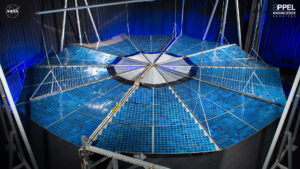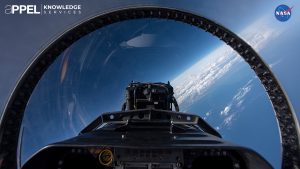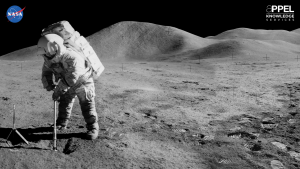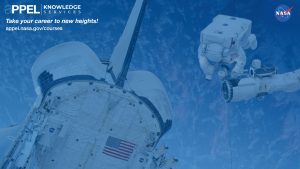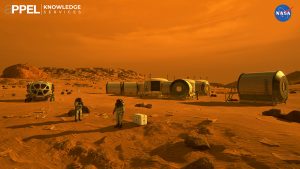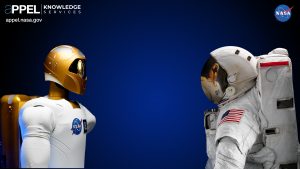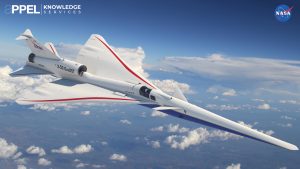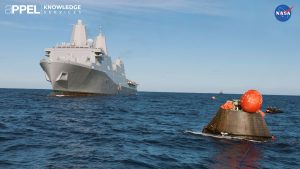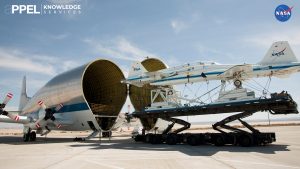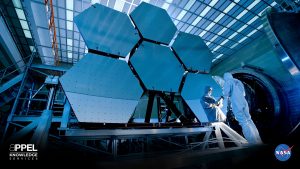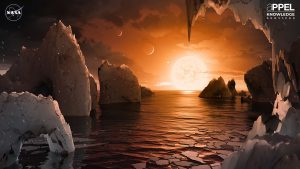Virtual Backgrounds
APPEL Knowledge Services created these virtual backgrounds to help elevate your digital presence during virtual meetings and as a salute to the sweeping changes you’ve made to advance mission success during a time of unprecedented challenge. Whether you choose to appear on your call from the surface of the Moon, the cockpit of an F/A-18, near an historic night launch at Kennedy Space Center, or from the Veil Nebula, 235 trillion miles from Earth, you are sure to impress.
Click here to view virtual backgrounds by title.
The Future Unfolds
Engineers at NASA’s Plum Brook Station Space Power Facility test the deployment of a MegaFlex high-performance solar array, which has very low mass and deploys by unfolding in space. NASA is developing the technology with commercial partner ATK to meet the anticipated power demands—350kW or more—of the future electric propulsion systems that could power long-duration human missions to Mars and beyond.
File type: JPG
Dimensions: 3840×2160 (4k)
Ratio: 16:9
Dare Mighty Things
NASA’s Perseverance Rover landed on Mars thanks to a supersonic parachute, shown here during testing in a wind tunnel at Ames Research Center. Designed to withstand speeds exceeding Mach 1.7, the 70.5-foot-wide parachute deployed in just under a second, providing crucial deceleration from nearly 12,500 mph in the thin Martian atmosphere. Engineers incorporated a hidden binary-coded message in its red-and-white canopy, spelling out “Dare Mighty Things.”
File type: JPG
Dimensions: 3840×2160 (4k)
Ratio: 16:9
Room with a View
The cupola is a small module on the International Space Station that enables astronauts to observe work outside the station, such as robotic activities, the approach of vehicles, and spacewalks. The six side windows and the center window provide spectacular views of Earth and celestial objects. The windows are equipped with shutters to protect them from contamination and collisions with orbital debris or micrometeorites.
File type: JPG
Dimensions: 3840×2160 (4k)
Ratio: 16:9
Operation IceBridge
NASA’s Operation IceBridge documents ice volume changes from Earth’s polar regions to help scientists better understand Earth’s changing climate. Flying sophisticated instruments over the regions, scientists can “see” beneath the mile-thick sheet of ice in Antarctica to find evidence of the lakes, rivers, and valleys that were carved below by ancient glaciers and then covered 14 million years ago. Pilots have flown at altitudes between 500 feet to 1,000 feet, to gather the data, which requires total focus for the 6 or 7 hours to successfully complete a mission.
File type: JPG
Dimensions: 3840×2160 (4k)
Ratio: 16:9
The Plumes of Europa
NASA’s Europa Clipper launched in October 2024 on a 1.8 billion-mile, five-and-a-half-year journey, to Jupiter’s moon, Europa. The spacecraft will make dozens of passes over the frozen moon, coming as close as 16 miles to the surface. The SUrface Dust Analyzer (SUDA) sensor head, shown here before launch in a clean room at the University of Colorado Boulder, will detect salts in the dust and ice near the surface. If Europa is emitting plumes from an ocean beneath the thick ice, the instrument’s data can help scientist determine if the water could be capable of supporting some form of life.
File type: JPG
Dimensions: 3840×2160 (4k)
Ratio: 16:9
Gateway to the Moon
In this artist’s illustration of Artemis VI, NASA’s Orion spacecraft delivers the Crew and Science Airlock to Gateway, a small space station NASA is developing to orbit at the Moon and serve as a critical staging point for scientific research, technology testing, and lunar surface missions. Once Gateway is in orbit, Artemis astronauts will dock with the space station, transfer to a lunar lander, and then descend to the Moon’s south pole to explore.
File type: JPG
Dimensions: 3840×2160 (4k)
Ratio: 16:9
First in Flight
NASA’s Ingenuity Mars Helicopter, shown here in an artist’s illustration, arrived at Mars strapped to the Perseverance rover’s belly. Ingenuity was a technology demonstration, originally planned for just five flights — the first powered, controlled flights by a human aircraft on another planet. But Ingenuity stunned the world, completing 72 flights before breaking a rotor blade during a hard landing.
File type: JPG
Dimensions: 1920×1080
Ratio: 16:9
Young Stars
Within the Large Magellanic Cloud, in the Dorado Constellation, is an unusual cluster of stars known as NGC 1850. It’s about 160,000 light years from Earth and was first observed in 1826 by Scottish astronomer James Dunlop. Astronomers today believe the cluster, recorded here in an image from the Hubble Telescope, is uncommon in that it is packed with “young” stars, about 100 million years old. Credit: NASA
File type: JPG
Dimensions: 1920×1080
Ratio: 16:9
Phytoplankton Bloom
There are trillions of Phytoplankton in Earth’s oceans. These tiny, varied, plant-like cells draw vast amounts of carbon dioxide—100 million tons a day—into the water and convert some of it into organic matter. Some scientists estimate that about 50 percent of the oxygen in Earth’s atmosphere was produced by phytoplankton. NASA’s PACE mission is designed to greatly advance our understanding of ocean biology and the relationship between ocean life and our atmosphere. Credit: NASA
File type: JPG
Dimensions: 1920×1080
Ratio: 16:9
The Veil Nebula
The Hubble Space Telescope has transformed scientific understanding of the universe—from its age, to the rate of its expansion, to the role of black holes within its galaxies. Hubble continues to produce stunning images, such as this one of the Veil Nebula, the visible remnants of a supernova formed by the death of a star 20 times larger than the Sun more than 10,000 years ago. Credit: NASA
File type: JPG
Dimensions: 1920×1080
Ratio: 16:9
A New Era
Artemis I marks the start of a new generation of space exploration. NASA’s powerful Space Launch System (SLS) produces 8.8 million lb/f of thrust at launch. The Orion spacecraft has 316 cu ft of habitable space, enough to house as many as six astronauts on a journey to the Moon. NASA’s Artemis astronauts will establish a long-term presence at the Moon, living on the lunar surface for extended periods and exploring the resource-rich south pole. Credits: NASA/Eric Bordelon
File type: JPG
Dimensions: 1920×1080
Ratio: 16:9
Full of Stars
This spectacular view of the International Space Station—250 miles above Earth and surrounded by the light from distant stars—was created by NASA astronaut Donald R. Pettit, a Flight Engineer on Expedition 30/31. Pettit combined 18 images, each with 30-seconds exposure, to duplicate the effect of taking a single, long-exposure image.
Credits: NASA/Donald R. Pettit
File type: JPG
Dimensions: 1920×1080
Ratio: 16:9
Giving Chase
Pilot Troy Asher, with videographer Lori Losey in the back seat, flies an F-15D from NASA Armstrong Flight Research Center on a mission near Seattle, Washington. The plane is serving as a chase vehicle, gathering crucial pictorial evidence of research to verify rain and snowfall observations made by a satellite. Credit: NASA
File type: JPG
Dimensions: 1920×1080
Ratio: 16:9
In the Cockpit
The cockpit of an F/A-18 research aircraft from NASA Armstrong Flight Research Center during a flight that included a quiet supersonic dive maneuver off the coast of Galveston, Texas. The pilot climbed to about 50,000 feet, then executed a supersonic, inverted dive as part of research to gauge reaction to sonic shockwaves of various intensities in advance of X-59 flights later this decade. Credit: NASA
File type: JPG
Dimensions: 1920×1080
Ratio: 16:9
Lift Off!
The raucous, 8.5-minute ride into Low Earth Orbit aboard the space shuttle began with the ignition of three main engines and a pair of solid rocket boosters, shown here lighting the night sky at Kennedy Space Center and churning out an impressive 6.6 million pounds of thrust. It feels like a catapult shot off the front of an aircraft carrier,” Commander Robert L. “Hoot” Gibson recalled. Credit: NASA
File type: JPG
Dimensions: 1920×1080
Ratio: 16:9
Magnificent Desolation
Beneath a black sky, Apollo 15 Lunar Module Pilot James B. Irwin uses a scoop to dig a trench in the ancient surface of the Moon during the mission’s second moonwalk. Irwin and Commander David R. Scott were the first astronauts to drive a vehicle on the Moon, exploring a much greater area than previous astronauts. Credit: NASA
File type: JPG
Dimensions: 1920×1080
Ratio: 16:9
New Heights
The Space Shuttle transformed human access to space. NASA launched 135 missions between 1981 and 2011, missions that deployed and repaired satellites, helped construct the International Space Station, and provided a unique platform for scientific research that couldn’t have been accomplished on Earth. Credit: NASA
File type: JPG
Dimensions: 1920×1080
Ratio: 16:9
On the Moon
Between 1969 and 1972, NASA landed 12 humans on the Moon, exploring the lunar surface, deploying research projects, and returning samples of lunar regolith and rocks that are still yielding scientific discoveries 50 years later. The first woman and the next man to land on the Moon are training now to establish a sustained presence there, one that will inform a future mission to Mars. Credit: NASA
File type: JPG
Dimensions: 1920×1080
Ratio: 16:9
On to Mars
The Artemis program will establish a long-term human presence at the Moon that will help NASA learn the lessons about living off the Earth for an eventual human mission to Mars. In this artist’s concept, astronauts have emerged from their habitats on Mars to explore the surface. Credit: NASA
File type: JPG
Dimensions: 1920×1080
Ratio: 16:9
Robonaut
NASA has developed several Robonauts—dexterous humanoid robots—that can help humans work and explore in space, sharing the same workspaces and tools. Robonaut 2, above left, launched to the International Space Station on space shuttle Discovery as part of the STS-133 mission, the first dexterous humanoid robot in space. Credit: NASA
File type: JPG
Dimensions: 1920×1080
Ratio: 16:9
Sonic Thump
The unique shape and technological innovations of the NASA X-59 are designed to reduce the startling booms of supersonic flight to mere thumps, no longer disrupting people in cities below and opening the door for the development of supersonic flight over land. Final construction and assembly of the X-59, shown here in an artist’s concept, is targeted for 2021. Credit: NASA
File type: JPG
Dimensions: 1920×1080
Ratio: 16:9
Splashdown!
Artemis astronauts will travel into space and return to Earth in the Orion spacecraft, splashing down in the Pacific Ocean as the Apollo astronauts did when they returned from the Moon. Orion is shown here about to be recovered in the Pacific Ocean after a reentry test of the capsule’s crucial heat shield and parachutes. Credit: NASA
File type: JPG
Dimensions: 1920×1080
Ratio: 16:9
Stars are Born
One of the first images captured by NASA’s new James Webb Space Telescope reveals this swirling, gaseous cavity in the Carina Nebula. In an area nearby, massive stars are being formed, creating intense ultraviolet radiation and hot stellar winds. The image encompasses a massive area, with the tallest “peaks” in this image about 7 light-years high.
Credits: NASA, ESA, CSA, and STScI
File type: JPG
Dimensions: 1920×1080
Ratio: 16:9
Super Guppy
The massive SGT Super Guppy Transport swallows two retired T-38 trainers mounted on a transport pallet, for a flight to El Paso, Texas, where the trainers were to be disassembled in 2013. The SGT’s hinged nose opens 110 degrees to give access to a cavernous 25-foot diameter cargo bay, capable of carrying Saturn rocket stages or International Space Station modules. Credit: NASA
File type: JPG
Dimensions: 1920×1080
Ratio: 16:9
The Future of the Moon
A new generation of NASA astronauts is training now for Artemis lunar landing missions, armed with a better understanding of the Moon and the resources it contains—resources such as water ice that could help sustain a long-term human presence there. In this artist’s concept, Artemis astronauts work on the lunar surface. Credit: NASA
File type: JPG
Dimensions: 1920×1080
Ratio: 16:9
The James Webb Space Telescope
Six of the James Webb Space Telescope’s (JWST) 18 ultra-lightweight beryllium hexagonal mirrors undergo testing. All 18 of the mirrors combine to form the primary mirror—about 6.5 meters from tip to tip, slightly more than 25 square meters in all—that will enable astronomers to peer farther back into time than the Hubble Space Telescope and see in far greater detail than ever before. Credit: NASA
File type: JPG
Dimensions: 1920×1080
Ratio: 16:9
The Search for Habitable Planets
As NASA works to identify Earth-like planets orbiting nearby stars, this artist’s concept imagines the surface of TRAPPIST-1f, one of seven planets orbiting an ultra-cool dwarf sun 235 trillion miles from Earth. The James Webb Space Telescope will give astronomers a much closer look at the TRAPPIST-1 solar system. Credit: NASA
File type: JPG
Dimensions: 1920×1080
Ratio: 16:9






